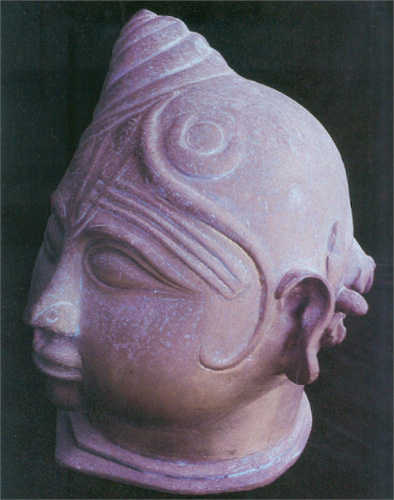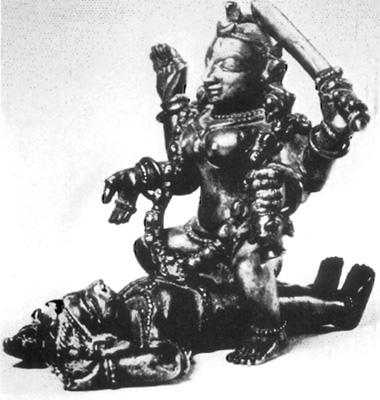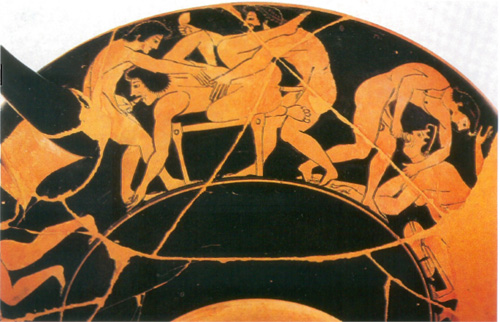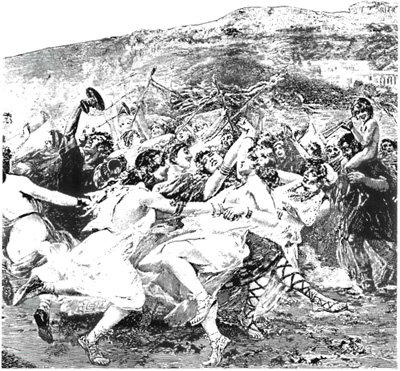8
NAMES AND ASPECTS OF THE ITHYPHALLIC GOD
In the forest" the name of the tiger is never pronounced; by the same reasoning the name of a god is never overtly stated. He is evoked only indirectly by adjectives. The word dieu (god) itself comes from the root div, meaning "radiant."
"In the Aitareya Brāhmana (ii, chapter 34, 7), it is prescribed that a formula must be altered from the form in which it occurs in the Rigveda in order to avoid the direct mention of the name 'Rudra' of the god. In another passage of the same text, it is interesting to note he is never named, but is referred to as 'the god here', and the same avoidance of the direct use of the name is also to be seen elsewhere" (P. Banerjee, Early Indian Religions, p. 49). That is why, in every mythology. the god-phallus is invoked under multiple names.
In the Indian pantheon, Rudra, "the Howler," refers to his terrible aspect, and Shiva, "the Protector," to his favorable one. Following the aspect of the faithful's preferred god establishes the secret and magical formula to be communicated to the apprentice at his initiation—a formula that will be his constant companion and recourse all the rest of his life.
Dionysus also appeared under his multiple aspects as a bull god, a god having a double birth, a horned god, and sometimes as a young Dionysus riding a panther.
Shiva, the ithyphallic god, is Prathamajā (first-born), the "eldest of the gods," and is also called Bhāskara (luminous), corresponding to the Phanos (he who illuminates) of the Orphic tradition. He engendered Skanda (the jet of sperm), the god of beauty and of the mysteries, also called Murugan or Kumāra (the adolescent), the equivalent of the Cretan Kouros (lad). He is Guha (the mysterious) whom the Greeks called Hermes.
THE ANDROGYNOUS GOD (ARDHANARĪSHVARA)
In the process of creation, "the power of conception (vimarsha) and the power of realization (prakāsha), when united, are embodied first in a point limit (bindu), a localization that is the departure point for time-space. From here is issued the vibration or sound (nāda) which is the substance of the universe. Space is a female principle, a receptacle; time is an active male principle. Their unity, symbolized by the divine hermaphrodite, represents Eros (Kāma), the creative impulse" (Karpātrī, "Shrī Shiva Tattva").
Primordial divinity is essentially bisexual. The division of the principle into two polar opposites is merely an appearance. The divine is defined in the Upanishads as "this in which the opposites coexist." "When Shiva and Shakti are united, their unity is sensual pleasure. Sensual pleasure is their reality; their existence apart is only fiction" (Karpātrī, "Lingopāsanā Rahasya'').
The reality of the world is therefore essentially sensual pleasure, the spark produced by the union of opposites. The hermaphrodite, image of the nondivision of opposites, represents absolute, pure, and permanent sensual pleasure, which is divine nature. "Bisexuality is one of the multiple formulas of totality-unity signified by the union of opposing pairs: masculine-feminine, visible-invisible, heaven-earth, light-darkness, but also goodness-wickedness, creation-destruction, etc." (Mircea Eliade, Histoire des eroyances et des idées religieuses, p. 178).
"The first creation consisted of spirits, genies, and demons issued from the mouth of the uncreated being as a materialization of his vital breath (prāna). Rudra appeared first, as luminous as the rising sun. He was androgynous.... The Immensity, on seeing this divine hermaphrodite, said to it: 'Divide yourself' It was thereby with the god's left side that a goddess was created who became his companion" (Linga Purāna, 41.41–42 and 99.15–19).
India: Bronze Shiva linga sheath, late eighteenth century. Photograph by Lance Dane.
In order to procreate a world outside of itself, the deity divided itself in half, and the two poles drew away from each other. The state of absolute happiness disappeared and is recreated only by the union of opposites, by love. The divine hermaphrodite "divided its body into two halves, one male, the other female; the male in that female procreated the universe" (Manu Smriti, 1.32).
India: Brass statue of Shiva and Shakti, circa eighteenth century. Photograph from Rufus Camphausen's Encyclopedia of Erotic Wisdom (Inner Traditions).
The initial principle can be conceived of as either masculine or feminine, as a god or as a goddess, but in either case it concerns an androgynous or transsexual being.
According to the Phrygian tradition related by Pausanias (7.17.10–12), Papas (Zeus) fertilized a stone phallus named Agdos, and the latter engendered a hermaphroditic being named Agditis. The gods, by castrating Agditis, transformed it into the goddess Cybele. She is the equivalent of Pārvatī, the lady of the mountains, the feminine counterpart of Shiva. Among the Canaanites at Ugarit, Anat, like other goddesses of love and war, is provided with masculine attributes and is considered bisexual. This is also the case with the Etruscan goddess. The Hurrite god Kumarbi is bisexual, like the Akkadian gods Tiamat and Zarvan. The Hittite Teshub, son of the celestial god Anu, is an androgynous deity. Images of hermaphroditic and ithyphallic deities from the Neolithic era are encountered everywhere. A wooden sculpture found in Somerset, England, is a typical example.
All degrees of bisexuality appear in the aspects of the god, virile in his terrible form, effeminate in his joyous and benevolent aspects. On the other hand, the goddess can appear virile and aggressive like Bhairavī or Kālī, the destructive power. In this case she plays the active role in her relations with Shiva, with whom she practices viparīta maithuna, inverted copulation. Again, by contrast, the goddess is modest, feminine and sweet when she appears as the lady of the mountains (Pārvatī) or Satī (Fidelity).
The same applies to Dionysus, who is sometimes represented as a bearded man in his prime, sometimes an effeminate adolescent. "At the opportune moment, Zeus undid the stitches on his thigh and gave birth to Dionysus, whom he entrusted to Hermes and had sent to Ino and Athanas, telling them to raise him as a girl" (Apollodorus, Bibliothéque, 3.4.3). Dionysus is captured by a barbarian king, who mocks him for his feminine appearance. According to Nicander, it was under the guise of a young girl that Dionysus warned the Minyades, who were absurdly hard-working and virtuous, not to neglect his initiation rites.
In a text of Aeschylus (fragment 61) the king cries out on seeing him: 'From where do you come, man-woman, and what is your country? What is this you're wearing?' The clothing that symbolized his double nature was removed: the saffron-colored-veil, the belt, the gold miter. He was stripped naked, though not stripped of his virility. but he was too fragile to give it value."
Hercules, the most virile of heroes, exchanged clothes with Omphalos. Arjuna, the valorous prince of the Mahābhārata, during his exile, disguised himself as a eunuch and taught music and dance to the daughter of King Virata.
In the myth cited by Aristophanes and retold by Plato in the Symposium, the first men were androgynes. As punishment for their rebellion, Zeus divided them in two. In the same vein, according to the Purānas, the first men were sages, who were still kindred of the deities and who engendered their sons by a kind of mental projection. It was to destroy their power, which the celestial beings believed threatened their own, that the gods created woman and reproduction by sexual union. In Genesis, the creation of the woman from one of Adam's ribs implies the androgynous nature of the original man, created in the image of the divine hermaphrodite.
Like Shiva, the first man, Adam, was man on his right side and woman on his left. All the Tantric rituals in which women participate are called left-handed rituals. The left side is man's weak side and is reserved for humble or impure tasks. That is why one never extends the left hand to be shaken. To offer an object with the left hand is viewed as a sign of derision. The circumambulation of a god's image must be done keeping to its right side-in other words, clockwise. In Tantric magic, when the feminine aspect of the divinity is to be invoked, this is done in the reverse direction. Every bisexual being can be considered an emanation of the transcendental aspect of the god. The androgyne, the homosexual, the pervert had a symbolic value and were considered in ancient civilizations to be privileged beings, images of the Ardhanarlshvara. Under this title they played a special role in magic and Tantric rituals, as in shamanism. "The final goal of Tantrism is the reunion of the two polar principles, Shiva and Shakti, in one's own body.... Initiatic androgeny is not always signified by a physical operation, as is the case among the Australians. In many cases it is suggested by the dressing up of boys as girls and girls as boys.... The homosexual practices attested to in various initiations are probably to be explained by a similar belie£ the knowledge that the neophytes, during their initiatic instruction, combine both sexes' (Mircea Eliade, Mephistopheles et ['Androgyne, pp. 139 and 149).
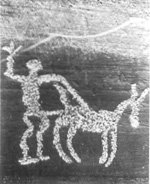
Italy: Rock carving from a sacred site at Val Comonica. Photograph by Mission E. Anati from Philip Rawson's Primitive Erotic Art {Weidenfeld & Nicolson}.
Among shamans, divinatory power is linked to bisexuality. In the ritual gesture of the anasynna, the magician dressed as a woman lifts up his robes to expose his sex, thus appearing as an androgyne. The Etruscan prophet carried a phallus attached to her belt. In the mysteries of Hercules Victor, in Italy, the god as well as the initiates were clothed as women. Cross-dressing was supposed to promote health, youth, and vigor and to lengthen life expectancy.
"In Siberian shamanism, the shaman symbolically combines the two sexes.... The shaman conducts himself as a woman, dressing in female clothes and at times even taking a husband. This ritual bisexuality-or asexuality-is supposed to be simultaneously a sign of spirituality, of commerce with the gods and spirits, and a source of sacred strength.... The shaman symbolically restores the unity of heaven and earth, and consequently maintains the communication between gods and men. This bisexuality is lived ritually and ecstatically; it is assumed as an indispensable condition for surpassing the condition of the profane man.... Siberian and Indonesian shamans reverse their sexual comportment in order to live in concreto ritual androgyny' (Eliade, Mephistopheles, pp. 144–45).
Greece: Attic cup, Late sixth century B.C. British Museum
"One cannot become a sexually adult male without having experienced the coexistence of the two sexes, androgyny; in other words, one cannot attain a way of particular and well-determined being without having experienced a way of total being" (Eliade, Mephistophélès, p.138)
The goal toward which the human species should aim is the progressive reintegration of the sexes until androgyny is obtained. The evolved being tends toward bisexuality. In the bisexual being, the communication between the two halves of the brain is particularly well developed. That is why the creative artist is often a bisexual, as are the mage and the medium, whence the role of those called "inverts" in magic rites and the importance attached to the rituals "of the left hand" in Tantric practices.
The myth of the divine androgyne is symbolically represented by the phoenix, which engenders itself and therefore represents immortality. When Christianity implanted itself in Rome, the phoenix became associated with the image of Christ. When the universe is reabsorbed, the two opposing principles will again be one; the hermaphrodite will reconstitute itself, first in the creatures and then in the divinity itself.
Bacchanalia festival. Illustration by Jim Harter.
Among the Dogon and the Bambara of Mali, the hymen is the materialization of man's female soul. An analogous belief is probably the origin of the practice of circumcision among the Semites.
THE PHALLOPHORIAS, FESTIVALS OF SPRING
Phallie processions and the installation of votive phalluses in Greece were part of the festivals of Dionysus, god of the suppression of bans and taboos. During the sixth century, Heraclitus of Ephesus remarked that if the procession and the phallic songs had not been in honor of Dionysus, they would have been embarrassing. Herodotus, who in Egypt had witnessed processions escorting the image of a phallic deity, concluded that the cult of Dionysus had come to Greece from Egypt. The rural Dionysiac festivals basically consisted of the promenading of a large-scale wooden phallus. The retinue was formed of figures wearing animal masks. Obscene jokes accompanied these spectacles. Aristophanes, in The Acharnians, gives a humorous version:
Diceopolis has concluded a personal arrangement that has allowed him to demobilize and return to the joys of civilian life. With his daughter as a canephore (basket-bearer) and his slave Xanthias as a phallophore (phallus-bearer), he gets ready to celebrate his own personal Dionysiac festival, which the war has too long deferred. He puts his little retinue in order, then begins intoning a canticle in which the phallus is personified under the name of Phales:
"Gather round, gather round ... you, the canephore a couple of steps further ahead. You, Xanthas, hold that phallus straight up. Put the basket down, my dear, so we can make the sacrifice....
"My master Dionysus, accept with favor this procession and this offering, which I and my family, released from war's misery, now hold to celebrate the Country Dionysias. May it bring blessing upon us, and may this thirty-year truce I have concluded bring me naught but happiness) Ah, daughter, carry the basket gracefully ... and with proper solemnity! Ah, a happy lad is he who will someday kiss you and make you fart, like a weasel, when you wake.... Now get going, and watch out in this crowd that no one sneaks up on you and lifts your jewels. Xanthias, it is up to both of you, the phallus and yourself. to stay perfectly upright, behind the basket-bearer. And me-I am singing the chant of the phallus. You, wife, watch from the terrace) Keep moving) Phales, comrade of Bacchus and his dinner companion, nightcrawler, adulterer, lover of boys, it has been six years since I've invoked you in my village with my songs. It is because I've made my personal truce with the Spartans and sent all my troubles packing to the devil. I won't be troubled any more by the war and the 'let's go to war.' Ah, now may things get better, Phales, Phales, as when one has caught the pretty slave girl from next door stealing some wood, then catches her in the rocks, grabs her around the waist, lifts her up and gives it to her! Phales, Phales, if after my party you need another drink to get your feet back under you, tomorrow morning, we will have a good potful and my shield will be hung peacefully over the hearth."
In the Dionysian comedies of fifth-century Athens, the phallus, proudly displayed by the actors and satyrs of the retinue, was one of the trumps fur success. The satyrs played flutes and displayed improbable erections.
At the time of village-organized phallophorias, several phalluses were promenaded. On a vase displayed at the Florence Museum, an enormous phallus can be seen, fixed on a sort of altar carried on the shoulders of ithyphallic figures. Participants climb on the phallus, which is made of a wooden beam whose end is carved in a gland-like form with an eye painted on its side. Ropes allow the phallus to be maneuvered and twitched about. An important phallophoria, one to which foreigners were invited, took place at the time of the Grand Dionysia of Athens; it is likely that the idol was better sculpted and more richly adorned.
Athena, according to Callixenos of Rhodes, described a procession that took place in Alexandria, under the rule of Ptolemy II Philadelphia with an incredible splendor, that assembled together hundreds of participants and paraded more than ten sacred chariots before the luxurious pavilion that had been erected fur the occasion by order of the king. An army of Sileni, satyrs, "ithyphalli," and maenads accompanied the god's images. Tableaus celebrated his prowess or exalted the gifts that he brought to mankind. In an Indian triumphal march of Bacchus, strange beasts and men of faraway lands were paraded. According to the narrator, "on another chariot was a golden thyrsus ninety cubits long and a silver lance of sixty cubits" and on another chariot was "a golden phallus one hundred twenty cubits long, covered with engravings and adorned with gilded strips, with a gold sun, six cubits in circumference, at its tip." The festival of Floralia took place in Rome at the beginning of May.
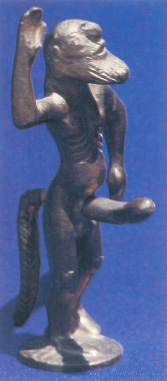
Thailand: Bronze ithyphallic ape.
The spring festival is the festival of Shiva. The festivals of Shiva are always the festivals of the humble and low-born. At the time of Holi, the spring festival that corresponded to Dionysia and of which carnivals are a survival, craftsmen and servants had the right to insult and mistreat their patrons, the nobility and the priesthood. This was done with the aid of many curses and obscenities. The Gana, Shiva's youngsters, did likewise with regard to the gods, sages, and brahmans. At the time of these festivals, large red painted phalluses and images of ithyphallic apes were paraded about. A figure dressed in white, representing Shiva, led the retinue mounted on a donkey. The participants flooded the spectators with jets of colored water, which brings to mind the confetti used at carnivals in the West.
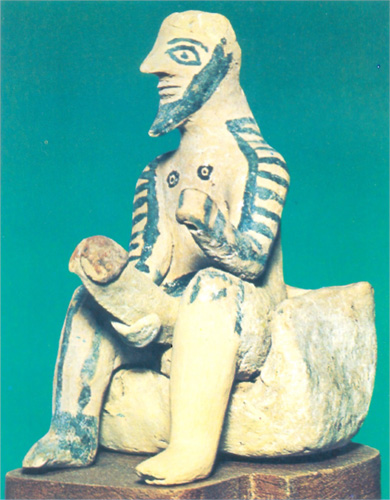
Greece: Clay satyr. National Archeological Museum, Athens.
In Rome, for the festival of Liberalia, the phallus Liber was transported across the countryside and the city on a chariot. Obscene remarks were a prelude to the erection of a phallus in the Lavinium forum. Saint Augustine mentions that in the course of the Liberalia an enormous phallus was paraded on a magnificent chariot covered with garlands of flowers. At the time of the Lupercalia, in honor of Faunus and Priapus, the naked Luperchs made the circuit of the Pelation, whipping the women with lashes to make them fecund. The festivals in honor of Bacchus and Osiris were called phallic. The Bacchanalia took place in Rome at the time of the grape harvest, October 23 to 29. The phallophores were the ministers of Bacchus who bore the phallus at the time of his festivals.
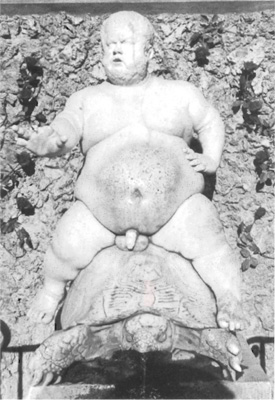
Italy: Statue of an obese nude, identified with Bacchus. Pitti Palace, Florence.
THE UNIVERSAL NATURE OF THE CULT
The phallus cult, which seems to have spread throughout the entire world during prehistoric times, has long perpetuated itself, even into the present, in various regions of the world.
Phallic representations in Egypt, Greece, and Italy are countless. The monumental sculptures of Delos are among the most famous. Images of the phallus are to be fuund wherever the Roman Empire established itself Nimes remained for a long time the center of the Priapus cult in southern Gaul.
In Sweden, the principal seat of the cult was in Uppsala. Adam de Brème, in his eleventh-century work De Situ Daniae, wrote that "the third of the Uppsala gods was Fricco, who was represented by a large phallus and spread peace and pleasure among mortals." On the occasion of a marriage a sacrifice was offered to Fricco.
Phallic images are to be found everywhere throughout Southeast Asia as well as in Indonesia and the entire Melanesian and Oceanic world. Phallic images can be encountered in the isles of Oceania, including Easter Island.
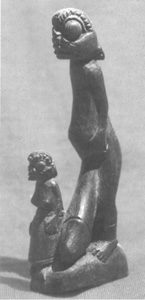
Indonesia: Ithyphallic wood statuette. Collection of Jacques Cloarec.
In Melanesia the phallus is worshiped in Sepik and in Borneo. Ithyphallic stone figures are still worshiped in New Guinea, whence a gold phallus comes as well. Phallus-shaped fish hooks are used by fishermen to catch sharks. The Polynesian statues of Hawaii, the Cook Islands, and the Tonga Islands are similar to those of New Guinea.
In the Americas, ithyphallic Mayan deities can be discovered in Mexico and Arizona. Stone phalluses were worshiped in Costa Rica and in Jamaica, where birds with male sex organs were also worshiped. An image of an ithyphallic dancer, dating from the beginning of this century, has been found in Colima, Mexico. Others of a more recent provenance come from the Taino. In Panama the Cuno Indians wear ritual bark costumes with large penises. From Peru comes a mortar in the form of a snake with a pestle in the form of a phallus. The vast numbers of erotic pottery pieces in Mexico, however, do not seem to be of a religious nature.
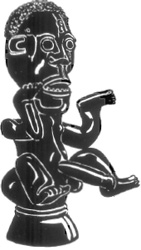
Nigeria: Headdress crown used as a mask. Repoussé leather.
"Among Siberian peoples (e.g. the Kumandin) a horse-sacrifice is accompanied by a performance by masked men wearing huge wooden phalli" (Philip Rawson, Primitive Erotic Art; p. 19).
More recently, in Cambodia, in a ceremony called the Popil ritual, the faithful circumnavigate a plateau, representing a vulva, crowned with a candle, representing the phallus. In Japan little stone phalluses are buried to ensure prosperity. In China it is a piece of triangular jade, the kwei, which is equivalent to the Hindu lingam.
Phallic altars are found in the majority of African countries. "In Ethiopia the phallic symbolism has perpetuated itself in the steep valleys that descend toward northern Kenya, where numerous monoliths are found that have been sculpted to resemble the phallus. Certain of them go back to the Bronze Age and are contemporaries of the ones at Stonehenge or Carnac, but others are relatively modern. Phallic tombstones can be found in the Bagiuni Islands off the coast of Somalia, but they are more likely to be found farther to the south, in particular at Bagamoyo and Tanganyika.
"The fact that many of the minarets of the mosques on the northern part of the coast are indubitably phallus-shaped adds an indigenous flavor to the East African culture, which remains, however, typically Islamic" (Basil Davidson, Old Africa Rediscovered, p. 184).

